Suzuki AX 100 Modifications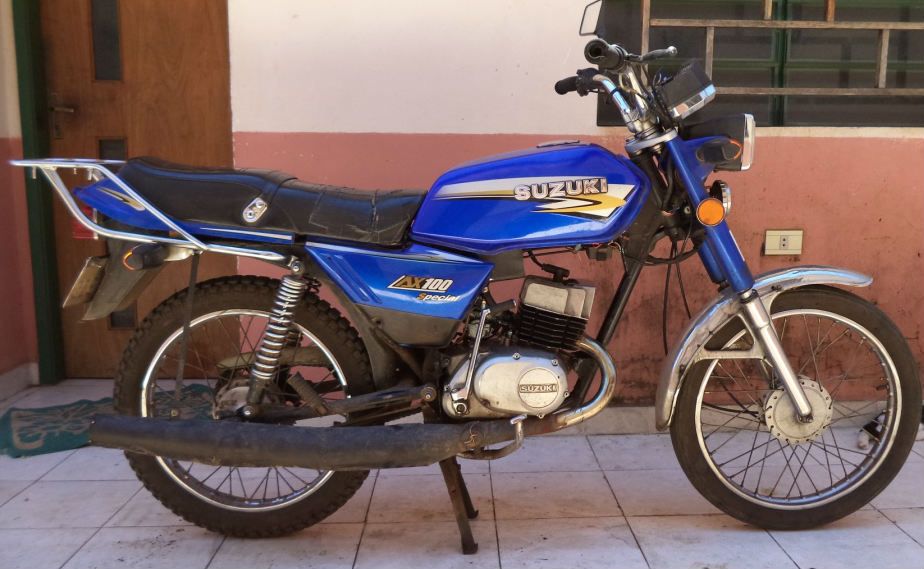 Reed Valve: Stock valve is only one flap (in 3 sections) instead of the normal two flaps. So that greatly limits its ability to deliver enough fuel at top RPM since its really only half of a reed valve. To enhance it I cut off the two ribs and replaced the 3 section steel reed with a single section of .5mm thick carbon fiber. It helped but even better was a fiberglass one (.015" thick) that I cut out of a sheet of fiberglass. It helped a noticable amount. (source: Radical RC) 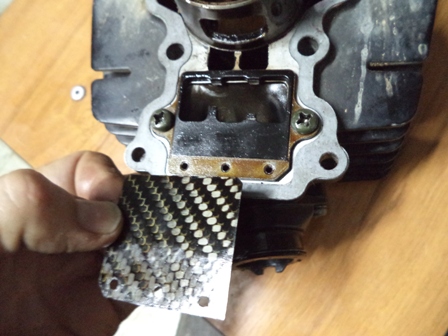 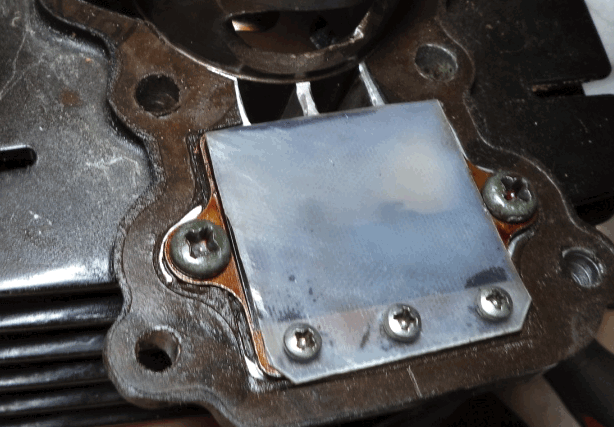 Porting: stock exhaust duration is 169 degrees, and the transfers/boosts are 124°. In order to get more high RPM power I had to raise the exhaust port so its duration is 184 degrees. Engine Compression: stock is only 120psi which is too low. I removed 1mm from the head mating surface to bring the pressure up to 155psi. That made a noticeable difference in power but eventually I brought it back down to 135psi with an extra gasket because the engine was getting too hot in the summertime. Exhaust Pipe: The stock pipe is the perfect design for a 4 speed bike but its internal stinger will gradually get smaller in diameter if you don't use a synthetic engine oil (so there won't be hardly any carbon deposits). If you want to race this bike then you need a normal expansion chamber but I warn you that it's a pain-in-the-ass on the street with one. That is because one designed for this bike has an extra long baffle return wave that interferes too much with intake when below the pipe powerband. The extra long belly/baffle is needed to produce the extra long return wave because there is a 3,000 RPM step between gears since the gearbox only has 4 gears. Stretching out the return baffle wave stretches out the RPM range by which the pipe has its supercharging effect. Below is my design for this bike. But I don't recommend it unless you also have a boost bottle to lessen the pre-powerband dip in power. In the drawing below the blue pipe is the internal belly stinger which greatly reduces noise. (Click here to read all about expansion chambers.) This design is the 4th I tried. For even better acceleration you can switch to a 46 tooth rear sprocket and a 13 tooth front sprocket.   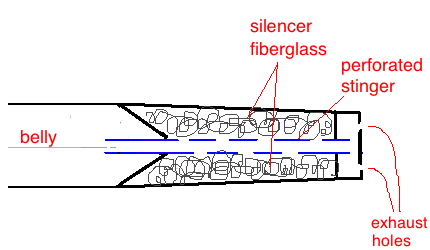 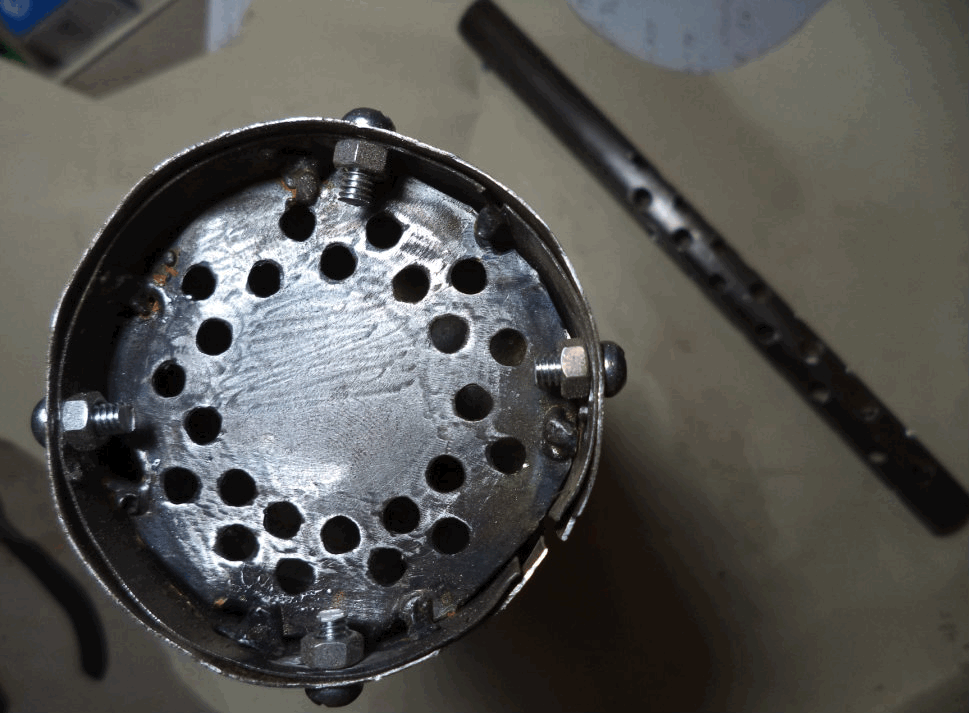
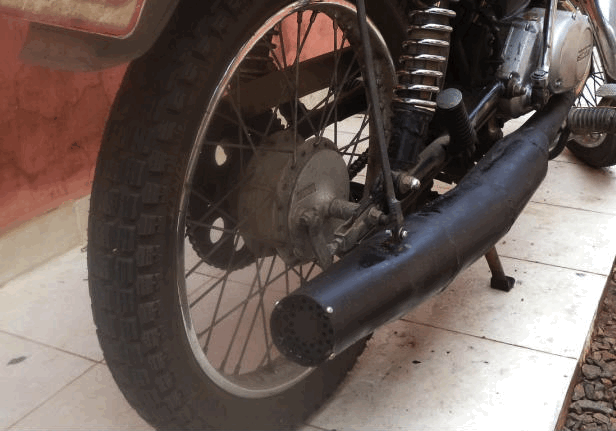 Power dip before getting "on the pipe": All expansion chambers cause a dip in power for about 1000 RPM right before the engine comes into the pipe powerband. The Yamaha boost bottle was designed to counter that dip. I designed and installed one and it did exactly that without any drawbacks. But I had to richen the idle jet with a larger .64mm hole and glue shut the two holes I had in the carbs slide. You can read up on the subject and get the details by clicking here. I don't recommend doing it unless you are skillful at such things because there was hardly enough room in the intake manifold for the hose connector and it is prone to cracking the JBweld I used there to cause an air leak. It is essential that the boost bottle be secured to the frame to lessen movement at the hose and connector. 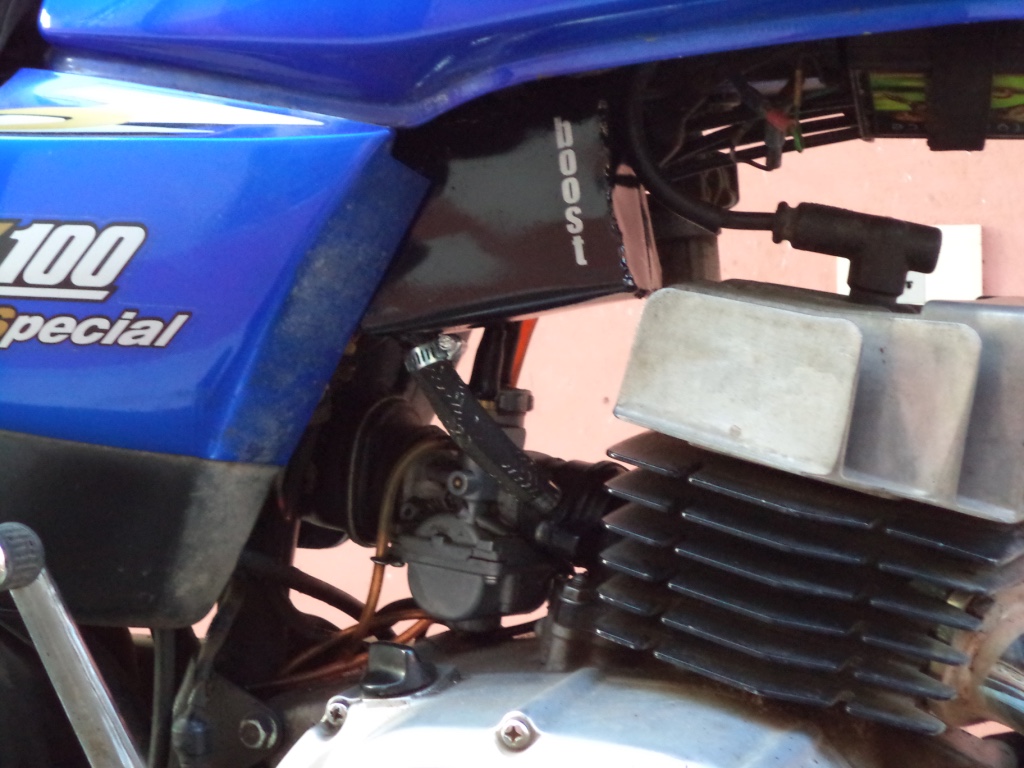 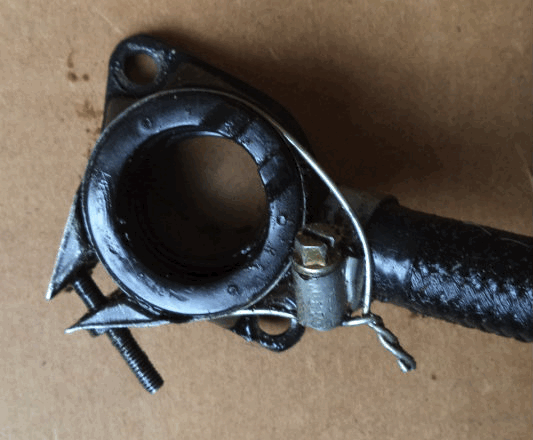 Ignition Timing: stock timing is correct for the stock engine but too advanced for a modified engine. So I installed a racing ignition coil and modified a KDX CDI that I made to suit the AX. It gives a timing curve better suited for the modifications listed here for better acceleration. (Let me know if you want one.) The stock CDI is not optimal for this engine. In all humble truth this CDI and ignition coil has made a really big difference in engine performance. I am very happy with them. I don't advise increasing engine compression without this CDI. Too advanced ignition timing with moderately high compression will cause too much engine heat causing seizures or piston deterioration from detonation. I can sell you the performance CDI or sell you its construction plans. My email is health@dragonfly75.com 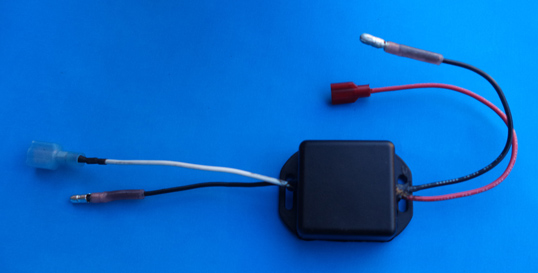  Carburetor: It is only a 20mm which is small but since the reed valve is so restrictive there is no sense in putting a bigger carb on it. Make sure the float bowl height is 21mm from the gasket. After installing my expansion chamber I increased the main jet size by drilling it out with a .9mm micro drill bit). And I increased the idle jet size by drilling it out with a .45mm micro drill bit (equal to a #42.5 idle jet). With the expansion chamber the mid throttle position gave too rich a mixture, even with the needle lowered completely. So I used my dremel to gouge out the part of the slide assembly that the needle clip rests on top of. So in effect I lowered the needle about 1.5 clip positions and drilled two 2.6mm holes at the bottom of the intake side of the carb slide and the engine ran clean without sputtering after that. (By "clean" I really mean it ran great all thru the RPM range.) Instead of modifying the slide to let the needle sit lower you can just buy the 4DH11 needle to lean it out more. Before switching out the ignition system I thought the off idle mixture was too rich because of inconsistent combustion but it turned out that the stock timing at low RPM was just too advanced because my CDI cured most of that problem. After putting in a 4DH11 needle my final jetting was #25 pilot jet and #95 (1mm hole dia.) main jet and the bike ran even better than with my modded stock needle. Piston: I drilled two holes in the stock pistons intake skirt which helps with more flow and more power at high RPM. The photo at the right is a GP100 piston showing the piston holes and where I cut off metal impeding the intake flow from the reed valve. 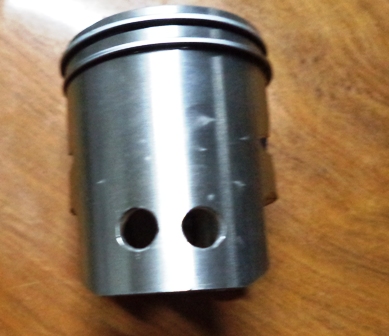  Intake Tract I used my rotary tool with cutting disc to make grooves along the walls of the intake tract and transfers to prevent gasoline from forming streams on the walls which become big droplets which burn much slower than gasoline mist. This gave a definite boost to power. 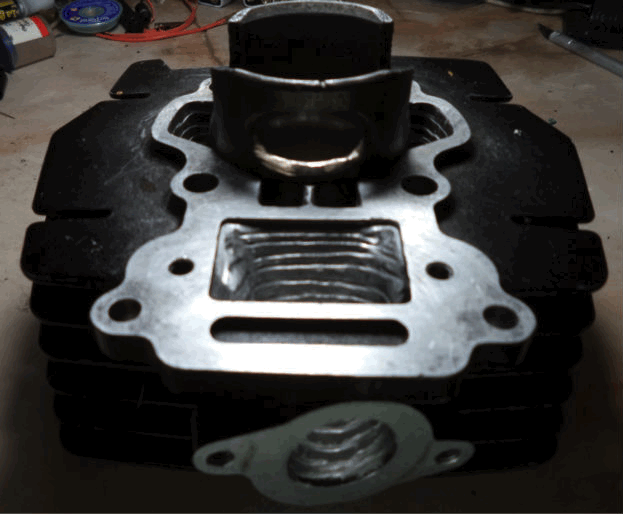 Dealing with engine heat: Ideally any engine that revs past 9000 or has 150psi or above should have a cylinder head with squish band to lessen the heat that the piston absorbs. But this engine is without a squish band so i decided to have a thermal barrier (ceramic coating) put on the piston top to help when the engine is run at top speed with outside air temps at least 90F. I sent off a spare piston I have to Swain Tech for application of thermal barrier coating. (If you send a piston to them first send it to a friend in the States for him to remail it to them. They will reject any shipment to them from outside the USA.) With the ceramic coating the engine maintains more power on hot summer days since excess engine heat robs engine power. Make sure you are not running as thin an oil to gas ratio as possible or you could get a "cool down seizure". That is because the ceramic coating, in addition to preventing absorbing as much combustion heat, prevents the piston from cooling off as quickly as the cylinder does when transitioning from high RPM to low RPM. When I ran too lean an oil ratio (by mistake) it seized on the 2nd run after coming off the highway onto a bumpy road that I went real slow on. Since then I've had no problem with it and I run either regular engine oil at 20:1 or semi-synthetic oil at 30:1. That was all with their "TBC" top coating ($26) which sometimes still lets the engine lose power at high temperature although not as much as before. Next I tried their "Gold Coating" which is 50% thicker (cost: $42.50) but it wasn't any better. I want to make a ram air scoop over the head like the Suzuki GT's have to force more air flow over the head to keep it cooler. 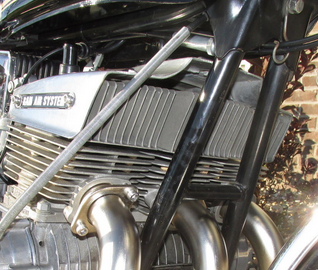 I have glued jeans cloth onto the top of the gas tank since the the sun gets the tank so hot I can hear gas vapor escaping out past the gas cap. That should provide some insulation to keep the gasoline from heating up as much. Some professional mechanics actually take off the gas tanks from motocross bikes that are being raced on summer days and keep them on ice till its time to get ready for the next race. And they have plastic gas tanks which conduct heat much less than our steel tanks! Here's a pic of my piston with the gold coating: 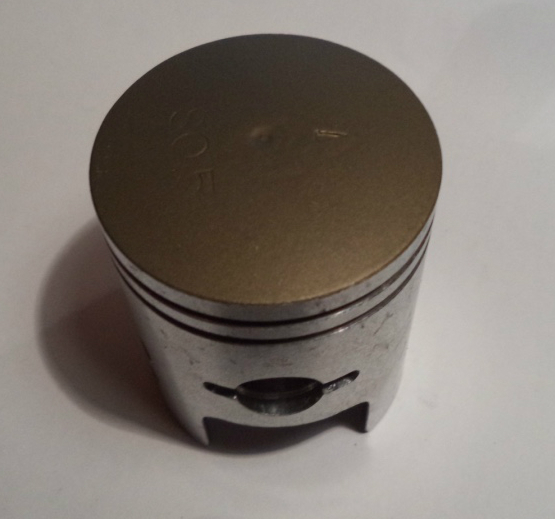 Next was suspension and handling. Stock fork angle is around 27 degrees which is fine for low speed turning such as when I am winding my way around cars stopped at a stop light so that I can get in front of all of them. But for high speed handling it is too steep. So what I want to do is put different forks and a bigger front wheel on it and then put different shocks on it that will let the front angle be around 29.5 degrees. It should handle like a champ then. Of course any suspension change will only give a plusher ride since the stock suspension is stiff and allows little wheel movement (3.5" front, 2.75" rear). The ideal shocks for this bike are the Progressive Suspension shocks, number 14-1282B from Powersport Parts for $105 and the 70-100lb springs are $64. The shocks are .25" longer but increase the wheel travel from 2.75" to 3.85" (a 45% increase) due to a shock travel of 3.50". I bought those shocks but got the ones that are 3/4" longer than stock because I had the machine shop make some 1.75" front fork extenders. So my AX sits about an inch higher at the rear and 1.5" at the front, which I like. I made the mistake of buying the 80-120 lb springs which are only good for me when I am giving someone fat a ride. (I weigh 150 lbs). But at least I solved the problem of the standard shocks bottoming out when we hit a bump or ditch. I plan on buying the softer springs later on. Notes: My home-made reed, made out of .5mm thick carbon fiber sheet, lasted till around 8000 km when I made and installed another one. I've tried it with and without a reed limiter with no observed difference which probably means the reed is too stiff to need one. At
almost 9000 km the red wire exiting the battery broke off which caused
a voltage rise which blew out my headlamp, tail-light, and speedo bulb.
So I advise everyone to tape that wire to the body of the battery to
not let it move any which will prevent it from breaking. I still
haven't found a correct headlamp replacement bulb (6v 25/25W) so if you
know of one then please inform me. It finally started to rain occasionally here and I found out that my Dunlop Mystic rear tire was terrible on wet roads. I replaced it with a tire with more grooves in the tread and that is flatter in the middle so there is more contact area with the road. This engine starts to lose power at a head temperature of around 290 degrees F which happens often here when the weather is hot. So I removed the engines side fins rubber noise absorbers for more air flow on the fins. I didn't notice any increase in noise. And I used my knife to scrape off dirt that had hardened onto the fins. That reduced the temperature at the head about 30 degrees to my surprise. But it still got hot too often before I had the piston coated. Cylinder Removal: It's easy once you know the final trick. Look at my pictorial on removing it: (click here) I
hate the rubber that the rear carb boot is made of since now it is rock
hard and has lost all flexibility. I have to soak it in hot water to be
able to get it to stretch onto the carburetor. This is critical because
the smallest amount of muddy water sucked in at that junction will wear
down the engine really fast. I put silicone sealant there. The swingarm hole at the right side has gotten bigger and allowed some forward/backward movement in the swingarm so I advise everyone to take out the bolt and lube it and the hole with a good quality grease. Suzuki had little or no grease there. The piston/rings I buy from EBay is for the A100 (predecesor to the AX100) which is the same except that the rings are thicker and the piston ring grooves are thicker to match. So rings aren't compatible between them. Here's a picture of the A100: 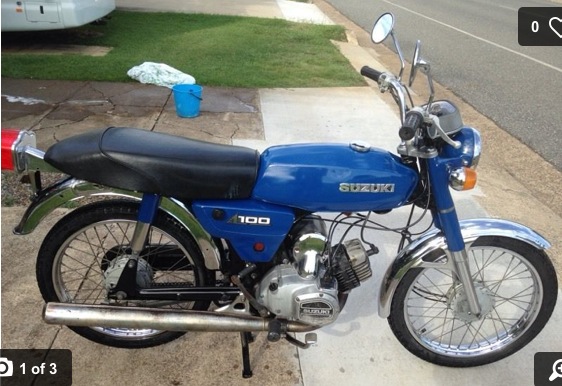 The latest piston I've bought is .5mm oversize which I needed after screwing up and adding half as much engine oil as is necessary which wore down the cylinder and allowed piston slap and loss of compression. It is 5gm heavier (only 4% more) and needed the inner skirt corners cut off to allow the piston to not hit the flywheel. The front brake never worked any good till I removed the lever at the brake drum and repositioned it so the recoil spring had more space. Turns out it was being fully compressed which ws stopping the full lever movement. The front left fork now has some sideways play in it, probably due to the torturous rock roads here. And both fork seals are leaking. If I had the time needed I would find a better front end that I could make fit on this bike, one that would make the front taller while increasing the fork angle for better handling and that would have better suspension and a bigger diameter wheel to better roll over the bumps here. It is hard to find gas here in South America without alcohol so for 3 years since I bought this bike I've been using gas with alcohol, partly just due to my ignorance of how bad it is for 2 strokes. It is usually 20-25% alcohol. Almost all the street bikes here are 4 stroke. Today I drained the tranny of oil and fired it up. No exhaust smoke because it has synthetic oil premixed in the gas. Then after refilling the tranny I fired it up again and lots of smoke came out the exhaust which means the right side crank seal is leaking due to the alcohol hardening it. The bike only has 20,000 km (12,500 miles) on it. I would never of believed that alcohol could have such a bad effect. Now I know, I've learned the hard way. Now I have to take the tranny apart which is hard without a propane torch to help get the crank bearings off. be warned! This last piston and rings I bought was made for a Suzuki GP100 which has a piston top lower about .5mm. It's only been on a few months and I took it apart and the rings are so wore down that the end gap is 1.5mm! So for now on I'm going to only buy original Suzuki parts and use the best synthetic or group 3 oil. Here's my page about engine oil: [page] I don't recommend piston/rings from oriental companies that aren't well known such as Wiseco, Vertex, Pro X, Athena. The problem is that the good companies don't make piston/rings for the AX100. The bad companies do but the mileage you'll get before wearing them down is about half of what would be with original Suzuki parts. And the rings have so much friction that they also wear down the cylinder so that you are forced to bore it out to the next size. I did a test measuring the force needed to push piston/rings thru the cylinder when it was off the bike and oiled well. It took twice as much force to move the non-Suzuki parts than the original parts. That is really horrible. I just bought an aftermarkt cylinder and I also bought original piston/rings to use in it. I'm now using Motul 800 Road Racing engine oil at 45:1 gas/oil ratio (because I disconnected the auto-lube system because it's not a good system and you should only use oil made for auto-lube if you use it) but I want to try Yamalube 2R at 23:1 or Motul 510 at 21:1. (these ratios were derived using my fuel/oil ratio calculator) HOME |